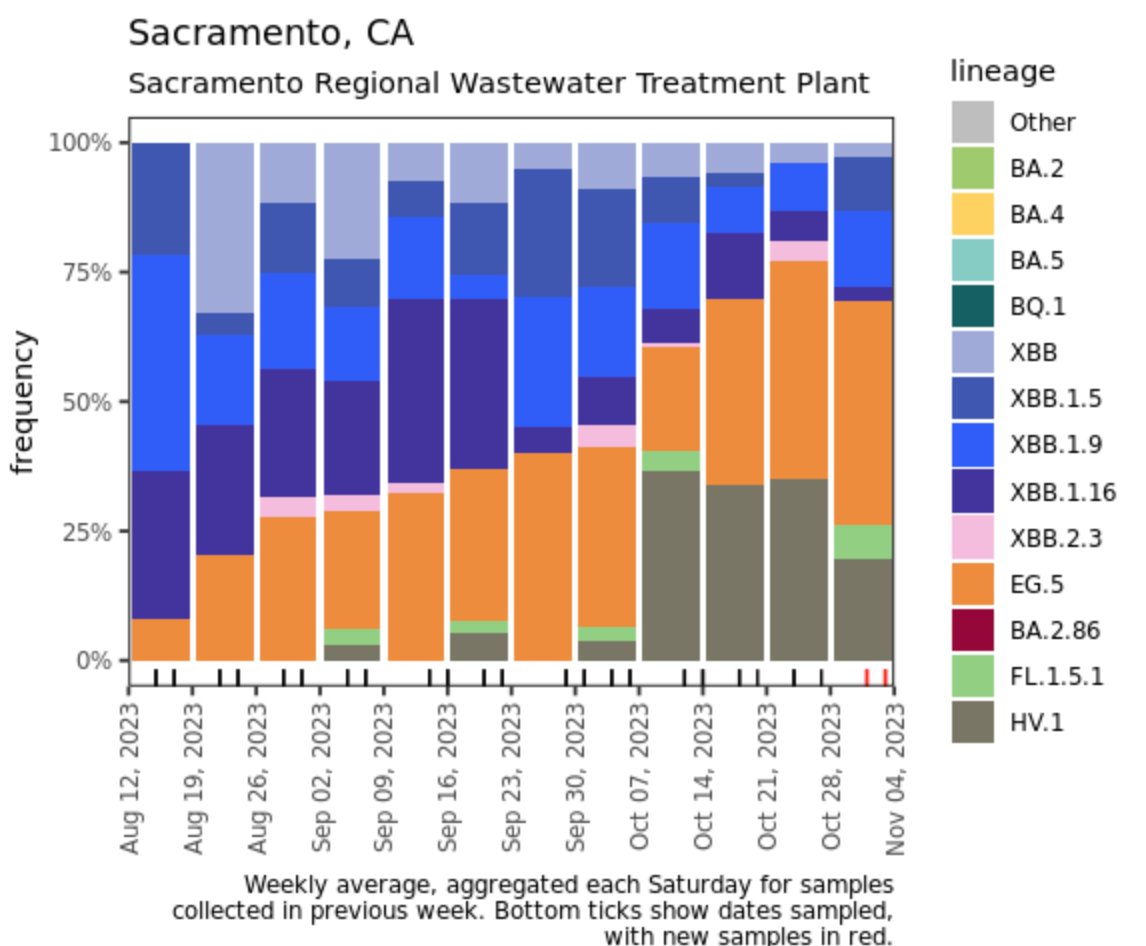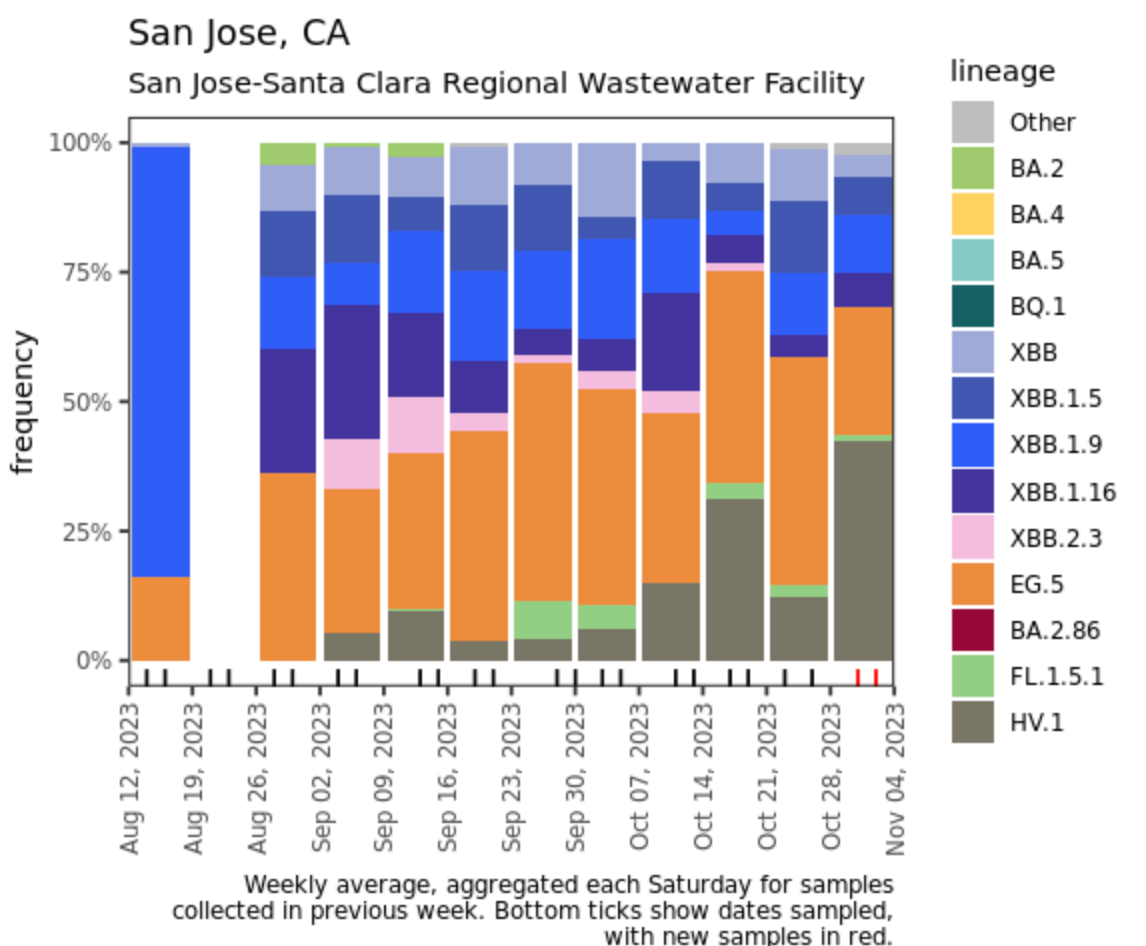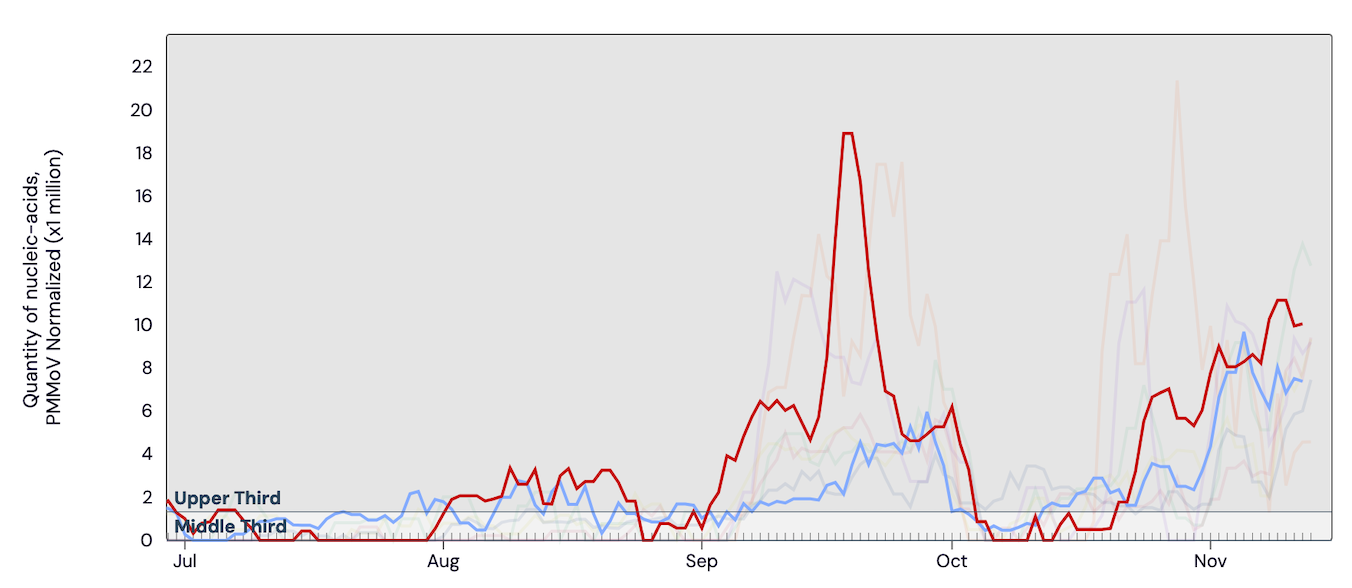SCAN Weekly Update - 11/15/23
This blog post describes data collected at 8 wastewater treatment plants in the Greater Bay Area of San Francisco, CA, including Sacramento, that are partners in the SCAN project which began in late 2020. The SCAN plants are a subset of the WastewaterSCAN plants.

All samples picked up by the couriers as of 11/13/23 have been processed and their data are on the site: data.wastewaterscan.org. Please email Ali at aboehm@stanford.edu if you identify any bugs on the site.
For more information about the Wastewater Categorization system (i.e., how LOW, MEDIUM, or HIGH categories are determined for each pathogen), please see "How are wastewater categories determined?" in the About page for wastewaterSCAN.
COVID-19
SARS-CoV-2 and Variants
SARS-CoV-2 N gene concentrations are between 10,000 and ~100,000 copies/g. In the chart below, the population weighted average line across all the SCAN plants (black) is compared to the SARS-CoV-2 concentrations at individual SCAN plants since June.

Below are the current SARS-CoV-2 wastewater categories for the SCAN sites (recall the category is determined by both the trend and the level):
Gilroy, SVCW, and Sunnyvale are in the LOW Wastewater CategoryPalo Alto, San Jose, Southeast SF, Oceanside SF and Sacramento are in the MEDIUM Wastewater Category
Below are all the data from all the SCAN plants for the last two years. You can access the graph here. The population weighted average across the SCAN plants is shown in black.

Below are plots from Oceanside SF, Sacramento, and San Jose showing the relative proportions of different variants inferred from sequencing the entire genome of SARS-CoV-2. Samples with low coverage are not being displayed in the plots (this explains the empty column for San Jose). Two new lineages (formerly sublineages) have been noted as potential variants and are newly distinguished in the plots this week: HV.1 (formerly included with EG.5) and FL.1.5.1 (formerly included with XBB1.9). Now that HV.1 is distinguished from EG.5, it is clear that HV.1 was contributing to the recent increases in EG.5 at Oceanside SF and San Jose, and it was ~25% of the most recent samples at Sacramento. Note that the sequencing data are always from samples taken between 1- 2 weeks ago.



Other Respiratory Targets
Influenza A & B, RSV, HMPV, EV-D68 and Parainfluenza
Influenza A (IAV) RNA concentrations are increasing across all SCAN sites, and three sites have met the benchmark for wastewater onset (Sacramento, Palo Alto, and new this week is San Jose). In the chart below, the National Levels benchmarks superimposed on the the IAV concentrations at Palo Alto (red) and San Jose (blue) since July.

Below are the current IAV wastewater categories for the SCAN sites (recall the category is determined by both the trend and the level):
Gilroy, SVCW, Southeast SF, Oceanside SF, and Sunnyvale are in the LOW Wastewater Category (not in onset)Sacramento is in the LOW Wastewater Category (in onset)Palo Alto and San Jose are in the HIGH Wastewater Category (in onset)
In the chart below, the population weighted average line across all the SCAN plants is shown in black for the full time series. The link to the chart below is here if you would like to interact with it.

Below is a chart showing the National Levels benchmarks superimposed on the IAV data from the SCAN sites (you can access this chart here). Currently, all SCAN sites have IAV concentrations in the upper third level.

Influenza B (IBV) RNA has been sporadically detected at most SCAN sites in the last 21 days. However, IBV has been detected in the majority of San Jose and Sunnyvale samples in the last 21 days. The heat map below shows all the SCAN sites as a row and each date as a column. The color blue means the sample was non-detect for IBV RNA and the colors get darker with higher concentrations. White indicates no sample was collected. We briefly stopped monitoring for IBV, which explains gap in data across sites in September. Here is the link to the heat map chart - the linked chart will update automatically as more data are added to the site.

RSV RNA concentrations have increased for most SCAN sites since the beginning of September, and all SCAN sites have now met the benchmark for wastewater onset. In the chart below, the population weighted average line across all the SCAN plants (black) is compared to the RSV concentrations at individual SCAN plants since July.

All SCAN sites are in the 'HIGH' Wastewater Category for RSV and are in onset.
In the chart below, the population weighted average line across all the SCAN sites is shown in black. The link to the chart below is here if you would like to interact with it.

Below is a chart showing the National Levels benchmarks superimposed on the RSV data from the SCAN sites (you can access this chart here). Currently, all SCAN sites have RSV concentrations in the upper third level.

HMPV (Human metapneumovirus) RNA concentrations are low at most of plants in SCAN, which can be seen below. The population weighted average line across all the SCAN plants is shown in black (link here to this chart if you want to interact with it).

Currently all SCAN sites are in the 'LOW' category for HMPV.
Below is a chart showing the National Levels benchmarks superimposed on the HMPV data from the SCAN sites. (You can access the chart here.) Currently, all SCAN sites have HMPV concentrations in the middle third level.

EV-D68 RNA was sporadically detected in samples collected in the last 21 days at SCAN sites. The heat map below shows all the SCAN sites as a row, and each date as a column since monitoring began in July. The color blue means the sample was non-detect for EV-D68 RNA and the colors get darker with higher concentrations. White indicates no sample was collected. You can access the chart here. EV-D68 is believed to occur biennially, and we saw it last year, so perhaps it will not be common this year.

Parainfluenza RNA has been detected in most samples collected from SCAN sites. The population weighted average line is shown in black. You can access the chart here.

Gastrointestinal Targets
Norovirus GII, Rotavirus, and Human Adenovirus Group F
Norovirus GII RNA is commonly detected at all sites. In the chart below, the population weighted average line for all SCAN plants (black) is shown compared to the Norovirus GII RNA concentrations at San Jose (blue) since May.

Below are the current Norovirus wastewater categories for the SCAN sites (recall the category is determined by both the trend and the level):
SVCW and Gilroy are in the LOW Wastewater Category Oceanside SF, Sunnyvale, Palo Alto, Southeast SF, and Sacramento are in the MEDIUM Wastewater Category San Jose is in the HIGH Wastewater Category
The plot below shows the Norovirus concentrations at the SCAN sites. The population weighted average line is shown in black. You can interact with the chart of all the plants at this link.

Below is a chart showing the National Levels benchmarks superimposed on the Norovirus concentrations from the SCAN sites.(You can access the chart here.) Currently, HuNoV GII concentrations at Palo Alto, Sunnyvale, Gilroy, and SVCW are in the lower third level and Oceanside SF, Southeast SF, Sacramento, and San Jose are in the middle third.

Rotavirus RNA concentrations are shown in the chart below; all the SCAN plants are shown together. The population weighted average line is shown in black. You can interact with the chart of all the plants here.

Human Adenovirus Group F DNA concentrations are shown in the chart below; all the SCAN plants are shown together. The population weighted average line is shown in black. You can interact with the chart of all the plants here.

Other Pathogens of Concern
Mpox, Candida auris, and Hepatitis A
Mpox DNA was not detected in most samples collected in the last 21 days at SCAN sites. The heat map below shows all the SCAN sites as a row, and each date as a column since July 2022. The color blue means that MPXV DNA was not detected in the sample, and the dark purple color means it was detected. White indicates no sample was collected. The chart shows all the data we have collected. You can access the chart here.

Currently all SCAN sites are in the 'LOW' category for Mpox
Candida auris DNA was not detected in most samples collected in the last 21 days at SCAN sites. The heat map below shows all the SCAN sites as a row, and each date as a column for all data collected since monitoring began in July. The color blue means that Candida auris DNA was not detected in the sample, and the dark purple color means it was detected. White indicates no sample was collected. You can access the chart here.

Hepatitis A RNA was detected in most samples from most SCAN plants and detected infrequently at Oceanside SF and Gilroy in the last 21 days. The heat map below shows all the SCAN sites as a row, and each date as a column for all data collected since monitoring began in July. The color blue means that Hepatitis A RNA was not detected in the sample, and the dark purple color means it was detected. White indicates no sample was collected. You can access the chart here.

